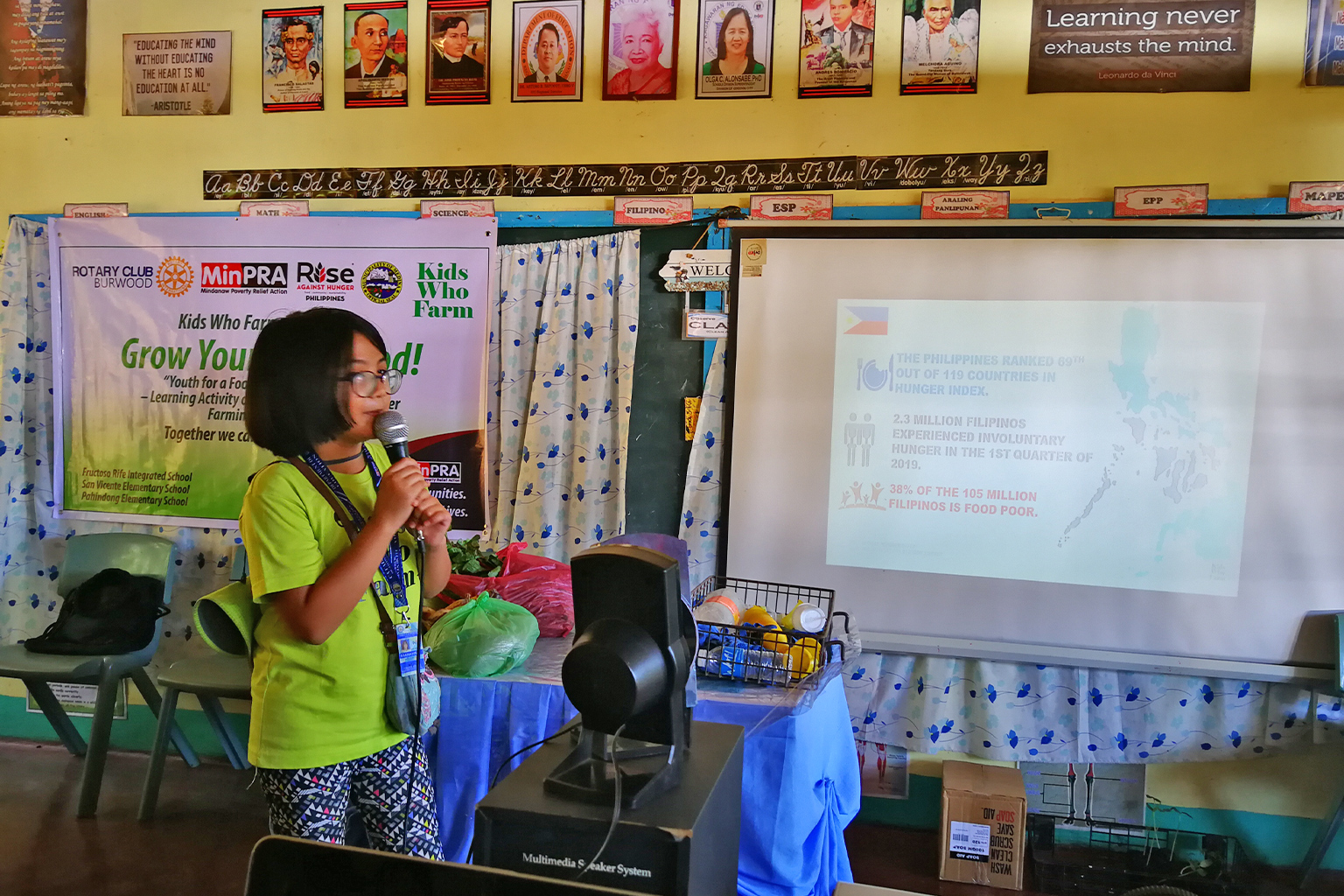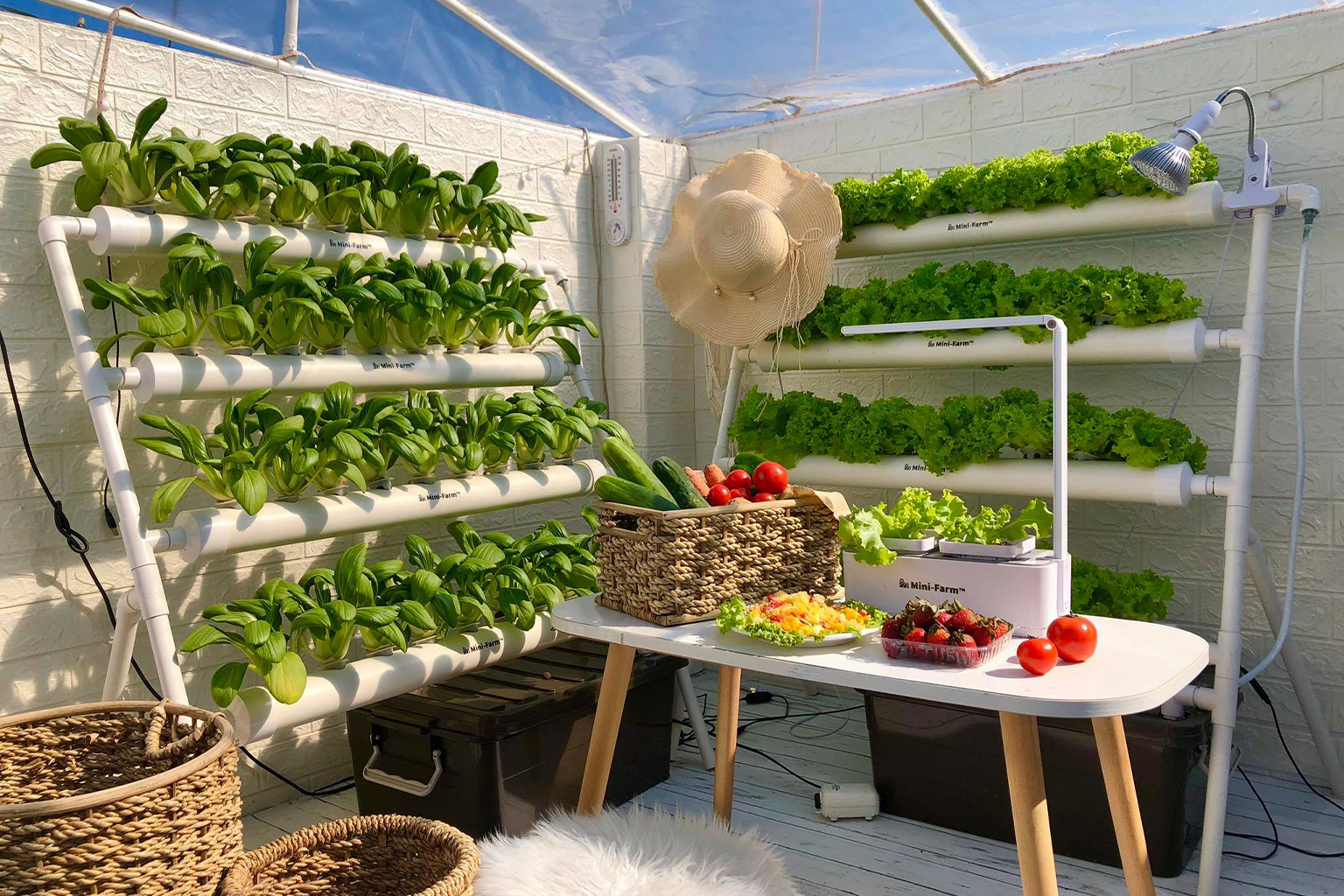- With the average farmer in the Philippines aged 53, and many discouraging their children from following in their footsteps, there are concerns that the country could soon face a critical shortage of people willing and able to produce the country’s food.
- Youth-led initiatives, such as Kids Who Farm and TikTok channel UrbanFarmerTV, are working to raise young people’s interest in sustainable farming techniques.
- Some lawmakers are also pushing to include agriculture studies in the high school curriculum.
In the Philippines’ southern island of Mindanao, 12-year-old Raaina Hinay teaches people how to farm.
Hinay is a co-founder of Kids Who Farm, an NGO based in the city of Zamboanga that teaches communities and schools how to start their own micro farms. Hinay started Kids Who Farm in 2019, when she was only 9 years old, inspired by her desire to save her school’s unmaintained fruit garden.
“[The garden] is flourishing now,” she tells Mongabay.
Since then, Hinay and her father have been leading workshops on the basics of sustainable farming for kids as young as herself and even adults, to assist them in setting up their own businesses. Hinay’s first workshop, at the age of 9, was with a class of university students more than twice her age.
“After that, we started teaching more communities and schools on how to build their own garden, almost anyone,” Hinay says.


Over the past three years, Kids Who Farm has established 38 community food gardens and school micro farms in 25 barangays, or wards, throughout Zamboanga City, and in two barangays in the northern Mindanao city of Cagayan de Oro, with 180 youth volunteers participating. The NGO has trained up to 3,000 young people on sustainable farming.
Hinay says she hopes to help tackle the Philippines’ twin challenges of aging farmers and the need to have a more sustainable and climate-resilient agriculture.
A looming farmer shortage
In August, members of Congress filed a bill that seeks to add an agricultural syllabus to the high school curriculum. Currently, farming as a school subject is only available for vocational school students — those who plan to enter the workforce immediately after graduating.
The bill cites the need to ensure food security through “a sustained supply of individuals” who will manage and develop the country’s agricultural industry.
A 2020 study by retired University of the Philippines anthropology professor Florencia Palis found that the average age of the Filipino farmer is 53. Citing the study, former agriculture secretary William Dar issued a warning last year that the country could face a critical shortage of farmers in the next 12 years.
Although the study examined data from 2009 to 2012, Palis said an upcoming paper of hers, with data from 2017 to 2018, has similar findings on the average age of farmers.
Palis’s research also revealed that farmers are likely to discourage their children from agricultural work due to its financial and physical burdens.
“If they are getting older, who will replace them? Who will produce rice to feed the Filipinos?” Palis says. “They no longer want their children to do that.”

Battling misconceptions
Emie Estialbo, 26, is one of the young adults who trained under Kids Who Farm.
A volunteer teacher from Capiz province in the central Visayas region, since September 2021 she’s also managed her family’s hydroponic farming business, growing plants in a water-nutrient mix without the need for soil.
Before receiving hydroponics mentoring from Kids Who Farm, Estialbo learned the basics of farming from her parents. When she was a child, her parents would bring her to the field to tend crops and vegetables. Estialbo says she pursued teaching because her father advised against pinning her future on farming alone.
“I followed my father’s advice not to commit to farming because they were raised as farmers, so they are aware of how hard the job is and how little they earn,” she says.
But since expanding the family’s vegetable farming business with hydroponic produce, Estialbo says they’ve gained a sense of security, especially in times of bad weather.

“Hydroponics came to mind because our area is prone to flash floods,” Estialbo says. “We’re near a river, so if it floods, our vegetable area becomes submerged and we go back to zero. I wanted to try hydroponics to avoid the loss.”
Estialbo’s hydroponic crops include lettuce, eggplants and tomatoes, which earn the family an additional 13,000 pesos ($220) per harvest on top of the monthly income from the regular vegetable farming business.
But for every success story like Estialbo’s, there’s the persistent problem of how to sustain young people’s interest in agriculture.
Estialbo teaches high school, where she says that youths still perceive farming to be tedious work. Hinay says her own dream is to become a programmer designing online games. But she says she’s also determined to continue her workshops until food insecurity is no longer an issue in the country.
“[I will] continue it until it becomes irrelevant because the issues we are spreading awareness of have been lessened or are completely gone,” she says.

The new age of farming
One young farmer who is using the popularity of technology and social media as an educational tool is 21-year-old Bea Suavengco, also known as UrbanFarmerTV on TikTok, the social media platform known for its audience that skews young.
In a year on the platform, Suavengco has amassed more than 88,000 followers, 80% of them from the Philippines, and her videos on hydroponic farming rake in hundreds of thousands of views. As an agriculture student, she says, she ventured into TikTok to convince young people that farming is more than just “poor man’s work.”
“I wanted to champion a new narrative so that we can inspire more youth to consider a career in agriculture,” she says.
Suavengco’s passion for farming began as a young child tending her family’s farm in Mindanao. Her parents weren’t farmers, so most of her knowledge came from self-study, sifting through articles and videos. She eventually started working for a U.S.-based startup as its “plant expert,” crafting guides on hydroponics.
Suavengco says she’s dedicated to pursuing a long-term career in agriculture as an entrepreneur, with plans to manage a social enterprise with an urban community garden and a tech startup that would produce videos about farming.
“I wish there [were] more people that will kind of mentor them [young people] or enlighten them about the big opportunities in agriculture,” she says.

Farming for the future
All three young farmers say it’s imperative that more members of their generation engage in climate-smart agriculture and spread awareness about food security. But can young people’s interest in farming actually make a significant impact?
A study shared with Mongabay that’s set for release in November by the Philippine Rice Research Institute (PhilRice) says young people have an important role to play in developing the agricultural industry. The paper examines how tech-savvy students effectively serve as “infomediaries” on climate-smart agriculture to rice farmers.
From 2012 to 2019, PhilRice enlisted high schools to have their students relay agricultural knowledge from text messages, the internet and reading materials to rice farmers in their households. The lessons covered general information on climate change, its effects, and adaptation and mitigation measures.
“When I think of the campaign, I think of a community that’s having issues [gaining] access to some of the most important information on rice cultivation [and] on rice farming-based system,” says Jaime Manalo, head of PhilRice’s socioeconomics division and author of the study. “I see the children as the link that would bridge these communities to that information.”
The campaign influenced farmers to adopt climate-smart technologies. In Manalo’s 2017 book, Communicating Climate Change in the Rice Sector, and a 2017 paper, “Climate-Smart Agriculture: Do Young People Care?,” he outlines success stories, including children convincing their farmer parents to reduce pesticide use and to build an observation well using durable bamboo. Not all such interventions were high-tech, Manalo notes, emphasizing that youth with or without formal education or access to technology have the capacity to be effective infomediaries.
The blend of both Hinay’s and Suavengco’s approaches can be seen through initiatives such as the infomediary campaign, but how these can be replicated on a larger scale remains to be seen.
Palis and Manalo say they’re in favor of the proposal to add an agricultural syllabus to the high school curriculum — adding an A to the Science, Technology, Engineering and Mathematics package to yield STEAM.

The lessons must be carefully planned, Manalo says, making them immersive and entertaining to keep the students’ interest, while engaging parents to secure their support.
Ultimately, both Manalo and Palis say that giving students the option to study agriculture would encourage them to consider it as a career path as well as address misconceptions about farming.
“You put in the students’ consciousness the importance of growing food and coming up with sustainable agricultural practices,” Manalo says. “Agriculture is also an emitter … so we need to be aware of the complexities of the agricultural production practices in order for us to properly address these issues.”
Banner image: Two young boys farming. Image courtesy of Kids Who Farm.
This story was produced with the support of Solutions Journalism Network, in collaboration with Climate Tracker.
Citations:
Palis, F. (2020). Aging Filipino rice farmers and their aspirations for their children. Philippine Journal of Science, 149(2), 351-361. Retrieved from: https://philjournalsci.dost.gov.ph/images/pdf/pjs_pdf/vol149no2/aging_filipino_rice_farmers_.pdf
Manalo, J. A. (2017). Climate-smart agriculture: Do young people care? Agriculture and Development Notes, 8(4). doi:10.13140/RG.2.2.29943.27046
